Latter-day Saints on Remote Azores Islands Are Living the “Higher Way” to Stay Connected to the Gospel of Jesus Christ
Contributed By Scott Taylor, Church News managing editor

São Mateus da Calheta, a western parish of the municipality of Angra do Heroísmo, as seen on September 16, 2019, on the southern coast of Terceira Island in the Portuguese archipelago of the Azores. Photo by Scott Taylor.
Article Highlights
- Latter-day Saints in the Azores have a rich legacy of membership and conversion in the Church.
- Despite their isolated location, Azorean members diligently serve in the Church, temples, and missionary districts.
“The ‘Church’ for Heavenly Father is each person—so you can be in Alaska or in the Azores, and He knows your name, He knows you, He loves you.” —Paulo Alves, Açores Portugal District president
Related Links
ANGRA DO HEROÍSMO, TERCEIRA ISLAND, THE AZORES
Paulo Alves remembers the moment from several years ago, sitting at a beach on the Azores’ Terceira Island, watching his wife, Tânia, and his young son, Samuel, roll up their pants and run to splash in the surf. The scene is indelibly etched in his memory—blue sky, blue Atlantic Ocean, and sounds of laughter and crashing waves.
“I looked to the sky and said, ‘Thank you, God. I know that the temple sealing is true and that I can have this family for eternity in the celestial kingdom,’” said Alves, now the Açores Portugal District president.
No matter that the Azores sit nearly a thousand miles away from the European mainland. No matter that members of The Church of Jesus Christ of Latter-day Saints are few on the remote islands. “We can live far away from the temple or another place on earth, but the sealings remain active in our lives,” he said.
President Alves wants Azorean Latter-day Saints to not only be part of a global Church but to learn from it as well. “When you’re isolated from the world, you have your own culture. But I believe in the Latter-day Saint culture. … I want the members here to follow the higher way—the higher standard.”
The Azores and the Church
The Azores—Açores, in Portuguese—is a nine-island archipelago in the middle of the North Atlantic Ocean 950 miles west of Portugal and one of that nation’s two autonomous regions. The islands are volcanic-formed masses at the junction of the North American, Eurasian, and African tectonic plates; if measured from the island peaks to their bases at the ocean’s bottom, the Azores’ “mountains” would rank among the Earth’s tallest.
With the islands identified as early as the 14th century, Portuguese settlers didn’t arrive until the next century. The Azores served as key locations first for explorers sailing from Portugal and other European nations and later whaling expeditions from the 1700s through the 1900s.
The islands’ natural erosion, combined with the mild climate, has resulted in green hillsides and fertile farmlands contrasting with black beaches and rocky shorelines. The predominant industries are agriculture, dairy, and fishing, with tourism rapidly gaining.
About half of the Azores’ quarter-million residents are on São Miguel Island, with another quarter on Terceira Island, home to military bases that have been either shared or leased at times by other countries since World War II.
While not officially recognized in Portugal until 1974, The Church of Jesus Christ of Latter-day Saints was represented 20 years earlier in the Azores by members assigned as military personnel to Terceira’s Lajes Air Field.
A servicemen’s group established in 1958 preceded the Lajes Branch organized in 1967. Maria Morgado, baptized by branch members that year, is considered the first known native to be baptized on Portuguese soil.
In 1979, the Portugal Lisbon Mission assigned the first missionaries to the islands. The first Portuguese branch was organized in Terceira’s Angra do Heroísmo, on March 5, 1980, with the Terceira Portugal District—now the Açores Portugal District—created in 1982.
A Legacy of Members
That year, 18-year-old Ricardo Resendez was baptized in Ponta Delgada on July 24—Pioneer Day. He had been interested in religion but shy; both a neighbor and his parents arranged for missionaries to visit him.
Desiring to share the gospel well before conversion, he faced military obligations before serving a mission at age 22. With his disapproving parents wanting him instead to keep working, Resendez left home with an airline ticket for his assigned Portugal and scant belongings—the trousers he was wearing, a pair of white shirts and some ties given to him by São Miguel elders, a pair of glue-patched dress shoes, and a small sports bag.
Surprised to see how little Resendez possessed, the mission president asked other missionaries to help expand his wardrobe. As his two-year mission ended, Resendez—currently the Ribeira Grande Branch president on São Miguel—received a call from his parents welcoming him to return home.
Alexandra Camacho Rodrigues, now the wife of district presidency counselor João Joaquim Pinto, is the Azores’ longest-tenured current member, baptized at age 18 on June 14, 1980, in the Atlantic Ocean. With the beach already crowded where her baptism was to take place, Camacho’s ordinance was moved to a smaller, more secluded spot where the surf pounded at jagged rocks.
Noticing Church missionaries before, Nair Alves thought the “Mormon” name she heard represented some sort of god. A kind gesture by an elder in the Angra post office led to introductions and a closer inspection of a missionary name tag and “The Church of Jesus Christ of Latter-day Saints.”
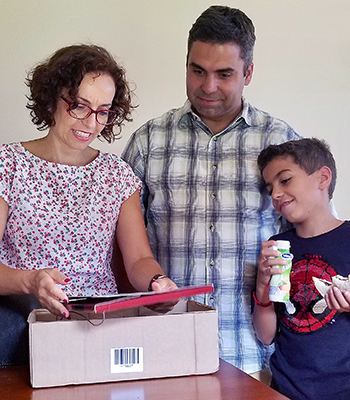
Tânia Alves, left, opens a box containing textbooks for her son, Samuel, right, while her husband, Paulo Alves, the Azores’ district president, looks on in their home on São Mateus da Calheta, Terceira Island, on September 16, 2019. Photo by Scott Taylor.
“I was amazed because it said ‘Jesus Christ,’” she recalled. “That was the name of my God, not another god—and I was happy.”
She and her husband, Luís Alves, and oldest son, Herberto, were baptized in 1985. Their second son, Paulo Alves, was only seven years old and baptized later.
While the islands’ strong Catholic traditions make conversion challenging, strong family ties have helped some be receptive to learning of the Latter-day Saint faith.
Nair Alves had lost her father to cancer at age 66. “I had a great desire to know about my father, to know what a spirit was, and I especially wanted to know that he wasn’t suffering any more,” she said, adding she prayed for understanding.
When meeting the missionaries at the post office, her first questions were if they believed in a resurrection and if they could tell her about a spirit world. Their responses paved the way for lessons in the Alves home.
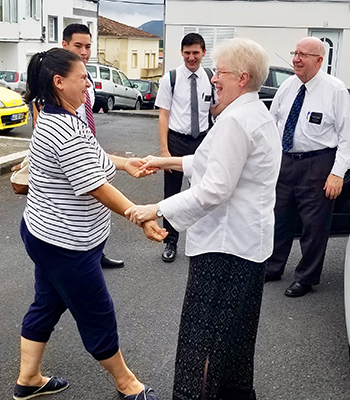
Lúcia Días, a recent convert of the Ponta Delgada Branch on the Azores’ São Miguel Island, greets Sister Louise Carter on the street on September 17, 2019. Behind them, from right to left, Elder Robert V. Carter, Elder Matthew Ethan Rhea, and Elder Jimmy Terron. Photo by Scott Taylor.
Similarly, learning the plan of salvation blessed recent convert Júlio Costa, who received a Book of Mormon on his first Sunday visit to the Ponta Delgada meetinghouse. “There was no doubt I was going back, because I felt something good,” said Costa, baptized in April.
Noting a grandmother who had helped raise him had passed seven years earlier, Costa anticipates going to the Lisbon Portugal Temple next month to help with his ancestors’ ordinance work. “Knowing that families can be together forever was revelatory,” he said. “The reason is to unite my family—to take their names to the temple and unite them on the other side of the veil.”
And 22-year-old Cátia Almeida remembers how embracing the restored gospel as a young teen helped lessen the absence of a grandmother who had passed away. “I really felt alone,” Almeida said. “But I found people caring about me. I felt the Spirit, and I felt a part of everything at Church.”
Mainland Connections
Despite the distance to Portugal and the European mainland, Church members in the Azores have benefited from long-distance connections.
João Joaquim Pinto and Alexandra Camacho Rodrigues were serving as missionaries in Portugal when they first became acquainted. Having concluded his mission, Pinto—who was baptized in his native Madeira, Portugal’s other autonomous island region—not only was permitted but encouraged to write Sister Camacho while she continued to serve. His parents refused to receive him in Madeira, so he instead went to the Azores to work and write and wait.
The Pintos were married in 1986 and sealed in 1989, with the two of them and her mother—who had joined the Church after her daughter—flying to Lisbon and then traveling by bus three days to the Frankfurt Germany Temple for endowments, sealings, and ordinance work there.
Paulo Alves and his wife, Tânia, who joined the Church in Portugal at age 20, first met at the Madrid Spain Temple as part of separate young single adult temple trips—his from the Azores and hers from Portugal. Married and sealed in 2008, they spent four years in Portugal, enough time for Paulo Alves to watch wards and stakes function there, fostering similar hopes for a future Azores stake.
In 2012, the Alveses moved back to Terceira, where he works as a pre- and post-op nurse and has served as district president for 20 months. “I believe it is the Lord’s will for us to be here to help,” President Alves said.
And Almeida first met her fiancé, João Barata, at an Especially For Youth conference eight years ago in Portugal, where he is from. A seven-year friendship led to a one-year courtship, following Barrato’s mission in Angola and Almeida’s mini-mission in the Azores.
But spiritual learning and progression doesn’t need a mainland kickstart. “I think there are a lot of members here with a lot of faith—they have to have it here—who have changed their lives with the gospel,” said Tânia Alves.
Rogéria Medina, baptized three years ago with her husband, said she relishes the spiritual learning. “We knew nothing of religion before we met the elders; it was not a big thing for us before,” she said. “I’ve learned things I had never learned in my life—the scriptures, how to pray—and I’m continuing to learn.”
A New Temple in Portugal
The distance from the Azores to the new Lisbon Portugal Temple is similar to that from Salt Lake City to Des Moines, Iowa, or New York City to Tallahassee, Florida. Yet, the Azorean Latter-day Saints are excited for the improved proximity to a temple, calling it a “one-plane” trip instead of the back-to-back flights or extended driving to get to temples in Madrid or Paris.
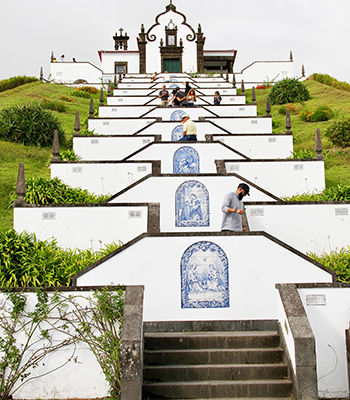
The stairways leading to the Our Lady of Peace (Nossa Senhora da Paz) Church featured tiled illustrations of the life of Jesus Christ. Photo taken September 17, 2019, above Vila Franca do Campo, São Miguel Island of the Azores. Photo by Scott Taylor.
Yet despite the distance and burdensome travels to temples, Azorean Saints have attended—and they have served.
Like the Pintos in 1989, when Luís and Nair Alves took their three children—Herberto, Paulo, and Nisa—and her mother for their first temple ordinances, they had to go to Frankfurt because the Bern Switzerland Temple was closed. The trip was compounded when Nair Alves’s mother suffered a stroke and required hospitalization in Germany for two weeks.
The Alveses have remained faithful in not only regularly attending but serving in the Madrid temple since 2003. Their annual service sometimes has lasted as long as three weeks, not including an 18-month Church service mission at that temple. They recently moved to start a similar service as the Lisbon temple’s first such service missionary couple.
President Alves hopes that as members attend the temple more frequently in Lisbon, the district will grow stronger—especially the younger generation. “The members have demonstrated their faith to the world by already going to the temple despite the distance.”
President Arnaldo Medina of the Ponta Delgada Branch said having a temple in Lisbon “should lift the faith of the members, and they feel better when it is closer. … And when some members step back into their old traditions, they need to work harder to stay on the covenant path.”
Added Rogéria Medina, his wife and the branch Relief Society president, “In the temple, we learn great respect for the ordinances. The respect we have for the covenants strengthens us to keep the commandments and be obedient.”
Challenging Isolation
Isolation from the rest of the world is just one challenge in the Azores. “Being a member of the Church on an island, it’s very different from being a member of the Church in another place,” said Tânia Alves. “So to be able to go to the temple more often will help us to live the gospel more fully.”
Technological advances—such as the internet and global communications—have lessened the isolation as well as aided in local Latter-day Saints’ progression.
President Resendez cites family history as an example. “I can be in my home and do everything. It’s really easy to do this work. We can access everything, and we can see the difference.”
Meanwhile, President Pinto continues to work with local municipal leaders in gaining access to civil records for digital archiving. His latest effort is São Miguel marriage records from the 1800s and 1900s.
While learning about the Church, Costa found the Gospel Library app—including the scriptures and Preach My Gospel. With his online learning, he says he could almost teach himself the missionary lessons—with the full-time sisters’ help, of course.
Still, young Azoreans face limited educational and employment opportunities and in turn, limited financial opportunities. It’s why Almeida and Barata—who will be married in a civil ceremony this month at the Ponta Delgada meetinghouse and then sealed several days later in the Lisbon temple—will live in Portugal after their marriage.
“It’s hard to leave,” said Almeida, “but at the same time, I feel like I’ve done everything here and I’ve changed.”
Another challenge is rotating callings among the few members, with the long-time Azorean Latter-day Saints having done a little of everything. President Alves has presided over two branches before becoming district president; his father, Luís Alves, and Resendez both have presided over branches and the district at different times.
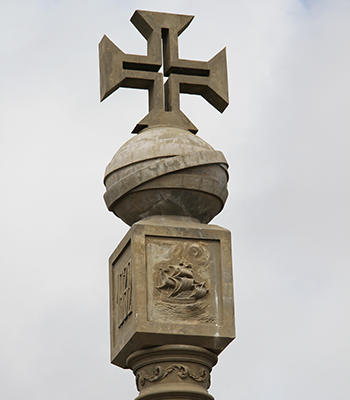
A closeup of the monument on Monte Brasil—marking Portuguese occupation of the Azores during the Age of Discoveries—shows national emblems of the cross and the armillary sphere, used by Portugal for centuries. Photo taken September 16, 2019, by Scott Taylor.
“The only callings I haven’t had are Relief Society president and Young Women president,” quipped Luís Alves.
New members can be quickly pressed into Church service, as is the case with President Medina, a convert of three years. “Day by day, I’m learning something new,” he said.
Local leaders are working to tighten up membership records, accounting for those who have passed away, left the islands, moved elsewhere, or disappeared. The district recently totaled upwards of 1,600 records, compared to a three-branch combined attendance of 110 active members.
Elder Robert V. Carter—who with his wife, Sister Louise Carter, are a senior missionary couple joining four companionships of young full-time missionaries serving in the Azores—has worked specifically on one São Miguel branch, where records were trimmed from 700-plus to just over 200.
After Elder Carter served as a branch president and Sister Carter as Young Women president, they had their first Azores mission cut short, with his cancer diagnosis forcing an early return to Pleasant Grove, Utah. Eleven months and a clean bill of health later, they returned and are midway in an 18-month call, having spent 32 of their 34 months in the Lisbon mission on the islands.
“We needed to come back,” Sister Carter said. “There were things we needed to do.”
Added Elder Carter: “There’s still a lot of work to do—we hope in the time we have left we can get the branches pointed in the right direction with the rudder set.”
Church’s Future in the Azores
Local leaders look to the next generation to further establish the Church in the Azores, with the youth, young adults, and recent converts augmenting what mature members have provided. Leaders point to Azorean missionaries currently serving—an elder in Brazil and a sister in London—and efforts like the islands’ first daily after-school seminary program started last year and district-wide youth and young single adult activities, like last month’s whale-watching excursion.
“I want to look to the members of the Church here like Heavenly Father looks upon us, because He works with our potential, and I want to work on this potential here,” said President Alves, adding “the challenge will be to help the members understand the importance of the temple in our lives. …
“The ‘Church’ for Heavenly Father is each person—so you can be in Alaska or in the Azores, and He knows your name, He knows you, He loves you. And I know we all have our own purpose in life—it’s part of His plan, where we are born, where we grow up, where we live. He knows His plan, and He knows why I was born here.”
Added Tânia Alves, “He loves us everywhere and anywhere. He wants us to grow here, to be strong here, and to be an example here—all the members, not just us. It’s a great blessing to be a part of that. Because wherever there are any humans, there are children of God.”
The Church in the Azores now has a temple only one flight away, an ongoing missionary presence, the blending of mature members with energetic young members, and increasing technology bringing the outside world closer to the islands.
“I can see a great future for the Church here in the Azores,” said President Alves, “because we’re trying to stay straight on the covenant pathway, to take the higher way.”

A view of Angra do Heroísmo, a UNESCO World Heritage Center site, in a photo taken September 16, 2019, from Monte Brasil on the Azore’s Terceira Island. Photo by Scott Taylor.

João Barata and Cátia Almeida—who are engaged to be married later this month and sealed in the Lisbon Portugal Temple—walk past the Ponta Delgada Branch chapel on the Azores’ São Miguel Island on September 17, 2019. Photo by Scott Taylor.

Nair Alves, right, greets Ben Clonts, one of the missionaries who helped teach and baptize the Alves family in 1985, at the Lajes Airport on the Azores’ Terceira Island on September 18, 2019. Photo courtesy of Paulo Alves.

A panoramic view of Sete Cidades, a parish of the municipality of São Miguel Island’s Ponta Delgada, along with the two volcanic-crater lakes, Lagoa Verde, left, and Logoa Azul, right. Photo taken September 17, 2019, by Scott Taylor.
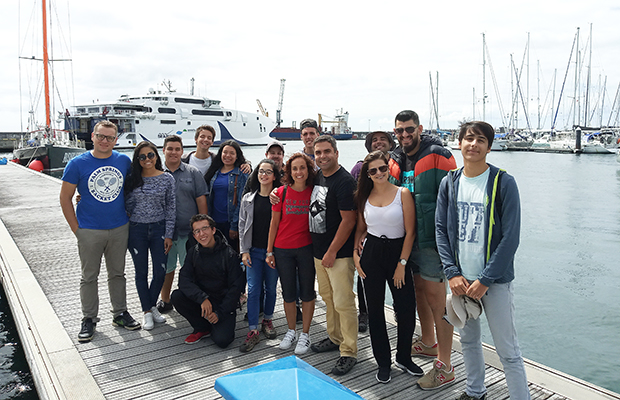
The young single adults of the Açores Portugal District gather for a whale-watching activity in Ponta Delgada, São Miguel Island, on September 7, 2019. Photo courtesy of Paulo Alves.
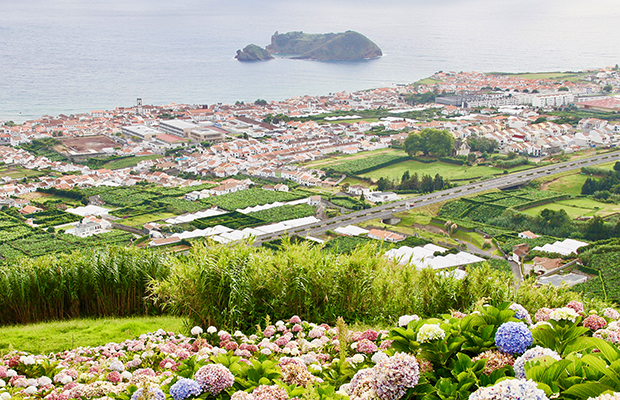
Overlooking Vila Franco do Campo and the Ilheu de Vila off the southern coast of the Azores’ São Miguel Island, as photographed on September 17, 2019. Photo by Scott Taylor.
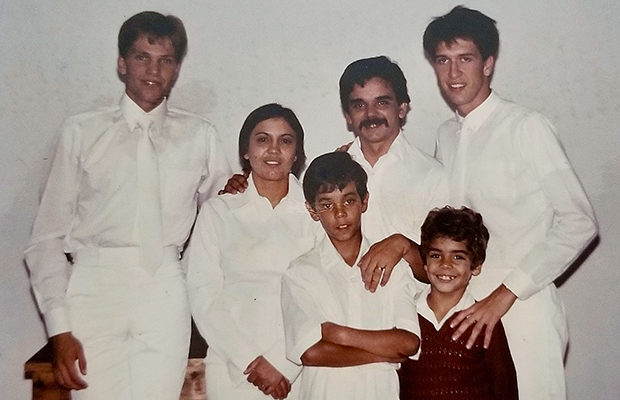
The Alves family of Angar, Terceira Island, on their baptism day in 1985 in Angar, São Miguel Island of the Azores. Luís Alves is second from the right, his wife, Nair Alves, is second from the left, with their two sons Herberto and Paulo, lower right. Photo courtesy of the Alves family.
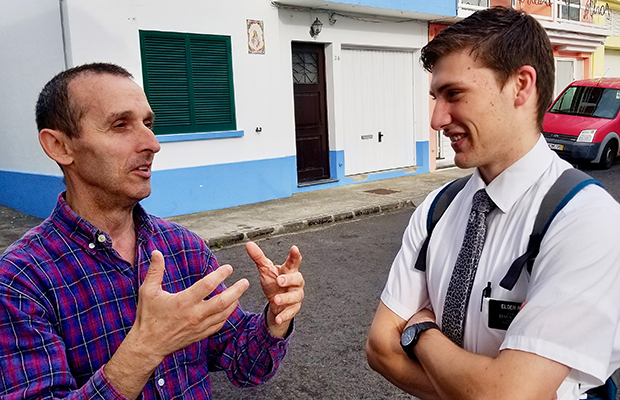
President Ricardo Resendez of the Ribeira Grande Branch, visits with Elder Matthew Ethan Rhea of the Portugal Lisbon Mission, serving on São Miguel island in the Azores, on September 17, 2019. Photo by Scott Taylor.
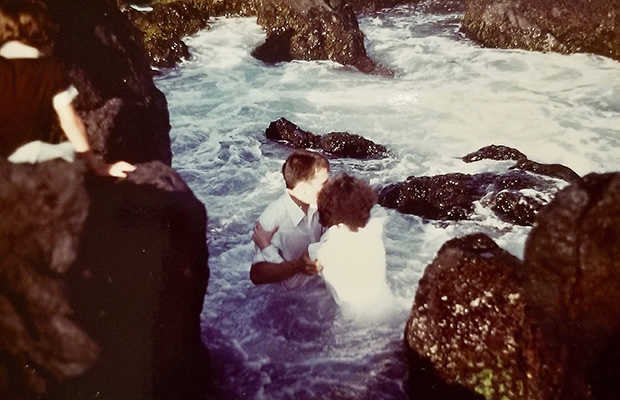
A photo showing the baptism of Alexandra Camacho Rodrigues, at age 18 on June 14, 1980, among the rocks and surf of the Azores’ São Miguel Island. Photo courtesy of Scott Taylor.
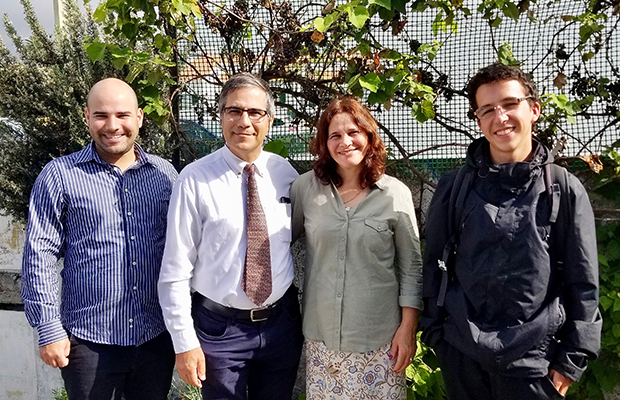
President João Joaquim Pinto, second from left, the second counselor in the Açores Portugal District, is photographed with his wife, Alexandra Pinto; their oldest son, Abraão, left, and recent convert Júlio Costa, right, in Ponta Delgada on São Miguel Island on September 17, 2019. Photo by Scott Taylor.
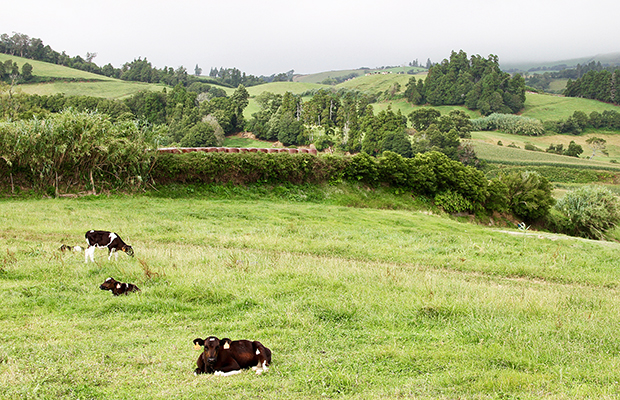
Cattle rest in a hillside field on the Azores’ São Miguel Island on September 17, 2019. Agriculture is the primary industry in the Azores, followed closely by tourism of late.

Two women work under a large tree at the side of the beach at the São Roque parish on the Azores’ São Miguel Island on September 17, 2019. Photo by Scott Taylor.
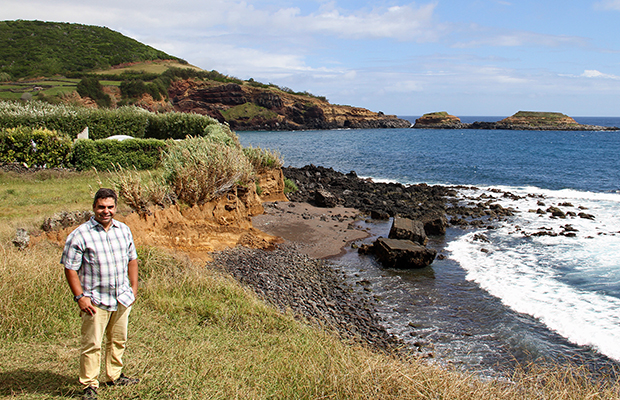
Paulo Alves, president of the Açores Portugal District, stands along the southeast coast of the Terceira Island on September 16, 2019. Photo by Scott Taylor.

The monument on Monte Brasil—marking Portuguese occupation of the Azores during the Age of Discoveries—overlooks the city of Angra on the Azores’ Terceira Island. Photo taken September 16, 2019, by Scott Taylor.
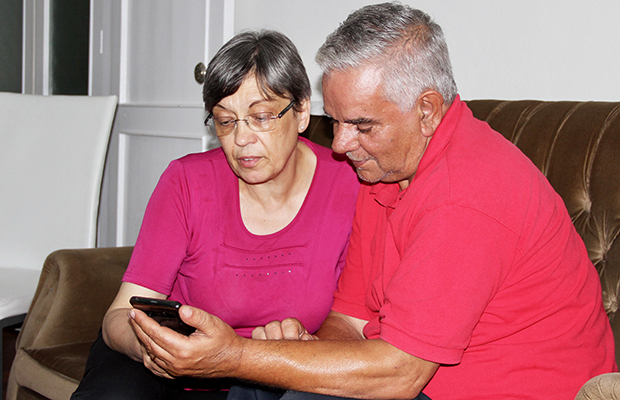
Nair Alves and Luís Alves read coverage of the Lisbon Portugal Temple dedication on a smartphone in their home in Angra, Terceira Island, Azores, on September 16, 2019. The Alveses have since left for Lisbon for a year-long service mission at the same temple.
